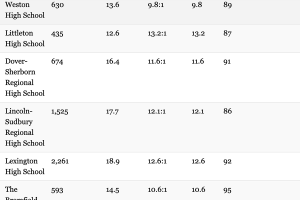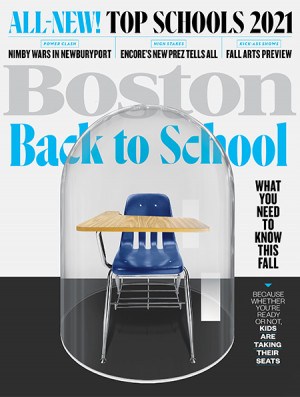The Future of Boston Latin
Twitter scandals, white privilege, and woke politics: How the city's most prestigious high school landed on the front lines of a culture war.
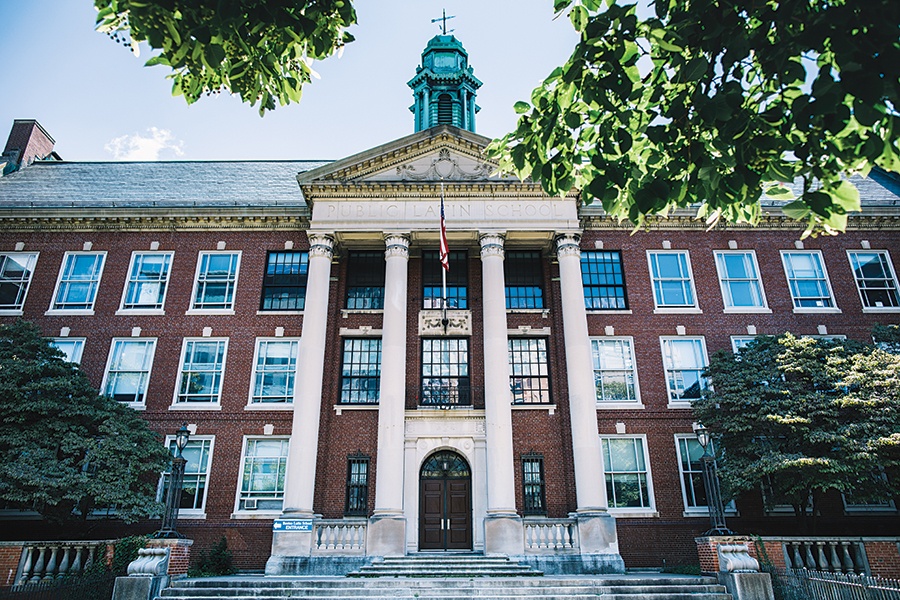
Boston Latin’s red brick façade and pillars make it look like a private academy, and its curriculum and pipeline to Harvard make it a rival to the state’s best private schools. But inside its halls, there has been a decades-long struggle to diversify the student body. / Photo by Matt Kalinowski
Rachel Skerritt, the outgoing Head of Boston Latin School, sat propped up in bed, trying to get some much-needed rest while taking a sick day this past May. Before disconnecting for the morning, she picked up her laptop and scanned the usual flurry of emails that piled into her inbox on a daily basis. Among them was a message from a parent with the subject line: “Poem in the Library.” She clicked on it, and her heart nearly stopped.
The parent referred to an essay that was hanging on the wall of the library, written by an eighth grader as part of a civics-class assignment asking students to talk about stereotypes in their community. A snapshot of the essay was included in the email. “To understand West Roxbury, you would have to be white and rich,” it read. The student went on to describe the neighborhood as “slightly racist” and rife with “Trump supporters,” “anti-maskers,” “Irish people,” and “blue lives matter flags on almost every damn house.” In the email, the parent expressed concern that prospective students—who’d soon be flooding the halls for tours of the city’s best public school—might get the wrong idea if they read it.
As soon as Skerritt saw it, she knew that in the current climate—one of the tensest moments in recent BLS history when it came to issues of race—the essay would likely cause a stir. Skerritt called her team at the school and decided the essays needed to be taken down immediately.
Hanging up her phone, Skerritt rolled over in bed and pulled up the covers. But the situation was far from resolved.
An online storm began picking up speed. Within minutes, Skerritt’s phone was blowing up with texts, voice messages, and emails from teachers, parents, and administrators. Soon enough, the media came calling.
It turned out that the uproar wasn’t entirely organic. Two West Roxbury residents, Lou Murray, who is a member of the neighborhood’s Ward 20 Republican Committee, and Tim Sullivan, posted a picture of the essay on Twitter and Facebook. In no time, the posts took on a life of their own.
As the controversial posts made the rounds among local conservatives, many demanded to know how the school could permit such racism in its hallowed halls. Would such an essay have been posted if a white student stereotyped the residents in Roxbury or Mattapan? There were accusations that so-called wokeness had run amok. Meanwhile, parents and observers were aghast that a student’s work—and name—had been splashed across social media to score political points.
A full-blown controversy in its own right, the incident also gave new life to the racially charged debate that has been raging ever since the school committee instituted a dramatic change in 2020 to the hyper-competitive admissions policy at Boston Latin and the city’s other two exam schools. In an attempt to diversify their overwhelmingly white and Asian student bodies, the schools began taking applicants’ socioeconomic status into account, converting the exam schools into ground zero for a bitter debate about affirmative action and diversity in public education. On one side are those who believe the school has the power and the responsibility to make the city, and the world, more equitable. On the other are Asian and white families who believe that, in an attempt to correct the sins of the past, Boston Public Schools is committing new sins by taking away seats from deserving children like their own. They contend it could very well ruin the best public school in the city along the way.
As a lawsuit challenging changes to the admissions policy heads to court and students return to school, the stakes couldn’t be higher. After all, the outcome of this epic, existential struggle over our most iconic public school could affect not just the school itself but the future of Boston.
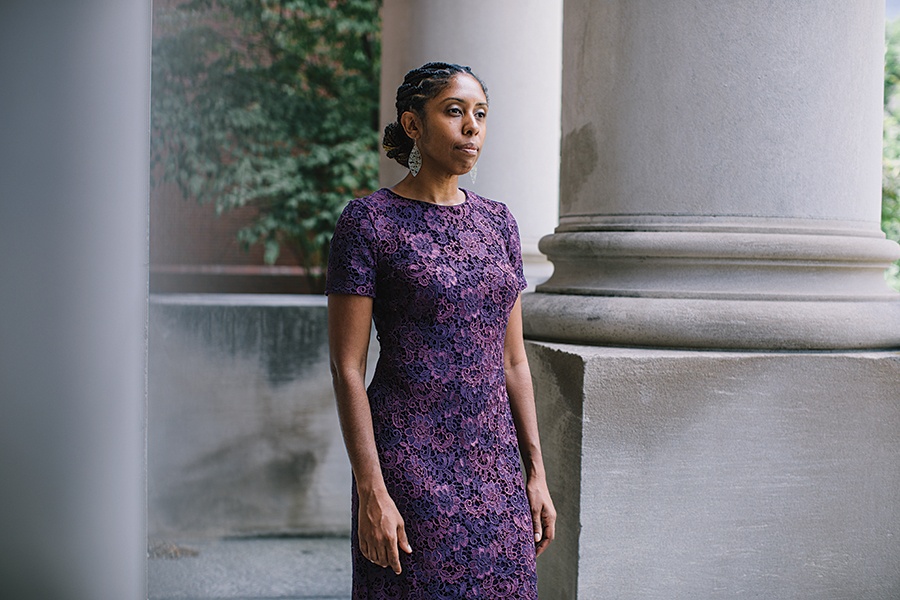
Former head of school Rachel Skerritt oversaw BLS during a season of tension over admissions and diversity. / Photo by Matt Kalinowski
There is a lot riding on where Boston Latin is headed—including a nearly 400-year legacy of academic excellence. Throughout the decades, the school has remained one of the finest in the nation. Its long list of accolades includes graduating four former governors plus the likes of Benjamin Franklin and composer Leonard Bernstein. It is regularly ranked as one of the top public high schools in the region and was recently ranked 26 on U.S. News & World Report’s list of the nation’s top public high schools. Considered a feeder school to Harvard and other Ivies, Boston Latin is the reason many families with means choose to stay in Boston and educate their kids here instead of moving to the suburbs.
Beneath the veneer of the red brick façade, wrought-iron gates, and marble hallways, though, lies a decades-long, highly contentious struggle to diversify the school’s student body. It wasn’t until 1877 that the first Black student graduated from BLS. Still, the school remained almost exclusively white until the historic 1974 busing ruling that sought to desegregate Boston schools. The landmark decision required that BLS, Boston Latin Academy, and the John D. O’Bryant School of Mathematics and Science—the three Boston schools that had instituted entrance exams a decade earlier—change their admissions policy to reserve at least 35 percent of their seats for Black and Latinx students. The resulting quota system remained in place for 20 years, and by 1994, Black and Latinx students made up 22.8 percent and 10.4 percent of the student population at BLS, respectively.
At the time, opponents of the ruling argued that establishing quotas would block some of the city’s top-performing students from admission. However, according to Michael Contompasis—who was the BLS headmaster for nearly the entire period—neither the school’s reputation nor its academic standing took a hit, and BLS actually expanded its AP offerings. Its SAT scores and college acceptance rates, meanwhile, remained steady. “I still contend,” he says, “that the benefits derived by admitting a more diverse student body were far greater in the long run.”
Then came a pivotal 1998 court ruling that once again changed everything. In the very first federal appeals court ruling on affirmative action in public schools, the U.S. Court of Appeals for the First Circuit found that the racial quotas at Boston exam schools violated the constitutional guarantee of equal protection. Boston Latin and the city’s other two exam schools were forced to drop the system and adopt an admissions process based on grades and test scores without taking race into account.
The change prompted a vertiginous drop in diversity at Boston Latin. By 2005, the student body was just 10 percent Black and 6 percent Latinx, and with such small numbers, Boston Latin could be a very uncomfortable place for many students of color. It wasn’t until roughly a decade later that Black students began to speak up about what it was like to belong to this small group—in a very big way.
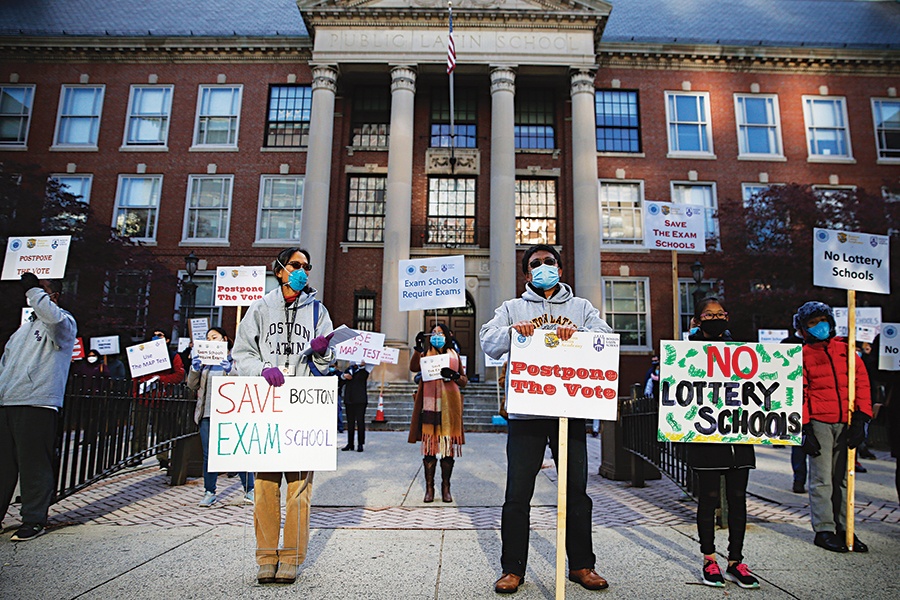
The intense debate over Boston’s Latin’s admissions process has spurred protests. / Photo by Jessica Rinaldi/The Boston Globe/Getty Images
It started with a YouTube video created by two Black female students in January 2016. The clip begins with their faces filling up the entire frame as they hit the record button. Then they back up, take a seat, and implore BLS students and alumni to “blow up every single social media you have…with the hashtag #BlackatBLS” to tell stories of the bullying, harassment, racism, and marginalization that they experienced within the school’s red brick walls.
One post at a time, social media users shone a spotlight on the state of race relations at the school. Alisa Regassa, a 2020 BLS graduate who now attends Harvard and was in eighth grade that year, wasn’t surprised by the student-led campaign to expose bias and inequities. A half-Black, half-white student, she says she witnessed occasional acts of racism at BLS. “You see things written on the bathroom walls that get covered up, but everyone talks about it,” she says.
The viral campaign was soon splashed across the pages of newspapers around the country. In Boston, the school district’s Office of Equity launched an investigation that concluded in a report that the school had mishandled multiple incidents of racial harassment. Simultaneously, the U.S. Attorney for Massachusetts at the time, Carmen Ortiz, launched her own federal civil rights probe. That investigation also concluded that the school had a culture of racial discrimination and harassment and that its staff mishandled student complaints—including one in which a male student threatened to “lynch” a Black female student. Ortiz declared that the school’s failure to appropriately address the incident involving the threat of lynching constituted a violation of the federal Civil Rights Act. The school’s head, Lynne Mooney Teta, resigned and apologized to students and parents for her failure to properly handle racial harassment at the school.
In the midst of the investigations, observers noted that if BLS had more Black and brown students, the school might be a more friendly environment for them. One of the obstacles they identified to having a more diverse student body was inequitable access to test prep.
Regassa, who went to the acclaimed Eliot School in the North End—one of the elite public elementary feeder schools to BLS—said she benefited greatly from the free Saturday test prep offered there. “That’s what made me do well, and that’s why I got in,” she says. “I had other friends that never had that. They didn’t have the time or money for that. There are definitely unfair advantages.”
The numbers back up Regassa’s personal experience. A 2018 Rappaport Institute for Greater Boston at Harvard study on admissions to Boston exam schools based on data from 2007 to 2013 found that families with resources have an unfair advantage in the admissions process because they can afford to pay for private elementary schools, expensive private tutors, and even admissions consultants to better prepare their children for the admissions test. Conversely, students from poorer neighborhoods often attend underperforming schools and lack the support and resources needed to get ready for and succeed on the exam.
It also found that 60 percent of white students and 78 percent of Asian students took entrance tests for the city’s exam schools during those years, compared with 26 percent of both Black and Latinx students. It attributed lower test-taking in those groups to, among other things, logistical factors. Free test prep is given at BLS, and the test is historically offered only at a handful of schools on a single Saturday in November. Both are problematic for students who lack transportation, have parents who work weekends, are helping raise siblings, or face other family or economic challenges. The study also cited some concerns about the test itself, such as the fact that it includes algebra and other topics not typically covered prior to students taking the exam at the beginning of sixth grade, giving a distinct edge to students who have outside tutoring.
In June 2016, Boston Public Schools increased the availability of free test prep for BPS students planning to take the exam and increased recruiting and outreach efforts to underserved schools. Still, there was a lack of awareness among students about the new offerings, and by 2018 Boston Latin’s student population was just 8 percent Black—the lowest percentage in decades. BLS’s Black population has remained around 7 percent in the past few years, far below the 33 percent of under-18 individuals in the city who identify as Black. Then COVID-19 and the national racial reckoning arrived, offering an opportunity to those who had long sought a more aggressive path toward diversifying Boston Latin.

The intense debate over Boston’s Latin’s admissions process led to the resignation of the chair of the Boston School Committee, Michael Loconto. / Photo by Stuart Cahill/MediaNews Group/Boston Herald/Getty Images
On a weeknight in October 2020, more than 100 people logged onto Zoom for a marathon nine-hour virtual school committee meeting. Ninety of them were waiting their turn for a two-minute slot to comment on issues before the committee that night, and none of those issues was more controversial than a working group’s proposal to drop the entrance test for BLS and the other exam schools for the 2021 to 2022 school year due to COVID and the learning disparities that left students of color at a disadvantage and negatively impacted them during the pandemic. At the same time, committee members were considering a quota system for admissions based on ZIP codes, with more seats reserved for those postal codes with lower socioeconomic indicators. City officials, experts, and committee members attested that such a policy could level the playing field for admissions—which consequently would improve the climate at BLS for Black and Latinx students. Many parents and students chimed in, voicing their support, and urged the committee to approve the plan. “As a Boston student,” Norma Rey-Alicea, BLS class of 1993, said, “you should have equitable access to a high-quality education no matter your neighborhood…. We’ll all benefit from giving students from every corner of this city a fair shot.”
At the same time, other parents blasted the school committee for a proposal they called unfair, rushed, and discriminatory against white and Asian students. Michelle Donovan, a 1995 BLS graduate and mother of four BPS students, including a sixth grader, told the board that the new plan “massively overstepped and altered the entire selection criteria with little to no input from highly impacted communities.” Yukong Zhao, an Asian American civil rights activist and president of the Asian American Coalition for Education, was more direct and animated, calling the ZIP code policy “unlawful” and “unconstitutional” and saying the city has failed Black and Latinx communities. “You need to fix that instead of using Asian Americans as a scapegoat for your policy failures,” Zhao said.
Despite some parents’ criticism that the new policy was essentially a form of racism, the school committee voted to approve the measure. Then some committee members gave those skeptical parents a reason to think they were right all along. When the moderator announced the next speakers in the public comment period—“Jennifer Hu, Yun Shen, Lingshen Dong, and Michelle Donovan”—school committee chairman Michael Loconto, off-screen, got caught speaking into a hot mike that he didn’t know was on. “That was like Shania, Shanaya, Shanaynay, Boo-Boo—and David, right?” he said, apparently mocking Asian Americans. Loconto resigned the next day.
Meanwhile, while many white West Roxbury residents were voicing opposition to the new policy, two other school committee members—Alexandra Oliver-Dávila and Lorna Rivera, who are both Latinx women—shared their views of the neighborhood and its residents over text messages:
“Wait until the white racists start yelling at us,” Rivera texted.
“Whatever. They’re delusional,” replied Oliver-Dávila.
Later on, “I hate WR,” Oliver-Dávila wrote, referring to West Roxbury.
“Sick of Westie whites,” Rivera replied.
“Me too I really feel like saying that,” Oliver-Dávila fired back.
Afterward, the Boston Globe submitted a public records request for communications sent during the meeting, but for some unknown reason, these particularly damning messages were not included in the city’s response. When someone leaked the messages and they became public, both committee members immediately resigned.
In July 2021, the school committee ruled for a second year that there would be no admissions test for exam schools (it would return for admission in the 2023 to 2024 school year) and instituted a permanent policy that divides applicants into eight so-called tiers based on family income, homeownership, and other socioeconomic criteria and guarantees the same number of student admissions for each tier. At the same time, it assigns 15 extra points to applicants who live in public housing, are homeless, or are in the Department of Children and Families’ care, and 10 extra points to applicants from schools where more than 40 percent of the student body is economically disadvantaged. The scoring for the 2022 to 2023 school year is out of 100 points.
All told, the new entrance policy constituted the most dramatic change to the admissions process in years—and was subsequently met with fury by some white and Asian parents who saw the chances of their children getting into BLS diminish before their very eyes. One West Roxbury mom who has two daughters in BLS, and asked not to be named to protect them, says moving trucks are rolling into West Roxbury as families with children younger than hers decamp for the suburbs, their chances of getting into the exam schools diminished. She doesn’t blame them and wonders if city officials understand the significance of this new phenomenon. “We work hard, we pay our mortgage, we pay our taxes, and we try and stay in this city and not abandon it for the suburbs, but now to punish [people like] us because of the ZIP code we live in is not fair,” she says.
It isn’t just white and Asian parents who are upset about the new admissions policy. Some low-income immigrant families—
precisely the students the new admissions policy should help—whose children attend schools that don’t meet the “40 percent economically disadvantaged” threshold for extra points also object to it. At a school committee meeting this past January, Jeannette Aitelhadj, a parent of a student at the Joseph P. Manning School in Jamaica Plain, broke into tears as she sat in her home and told the school committee via Zoom and through a Spanish translator that her son “likes to read and write and wants to become a famous writer,” but that because he is at the Manning School and does not qualify for the extra 10 points, he will not be able to achieve the American dream. “It is not his fault that BPS has placed him since first grade at the Manning,” she said. “How can I tell my son he cannot achieve his dream because he was placed at the Manning?”
Another parent of two Manning School students also questioned the points system. “I really don’t understand. We sent our children to the school they were assigned to by BPS,” Daniel Noemi said through a Spanish translator. “Mayor Wu makes over $200,000 a year. Why [did her children get the extra] points and people in this community, people like me, did not?”
Many critics of the new policy say they aren’t just opposed to the changes because their children may now have a tougher time gaining entrance, but because they believe the school itself will lose standing. They predict that the policy will lead to the admission of less-qualified students, a lowering of standards, and ultimately a deterioration of educational quality. In other words, they believe these changes will herald the end of BLS as we know it. “Like Harvard is the crown jewel of colleges, Boston Latin School is the crown jewel of Boston high schools,” says the West Roxbury mother. “What is happening now is turning it into cubic zirconia.”
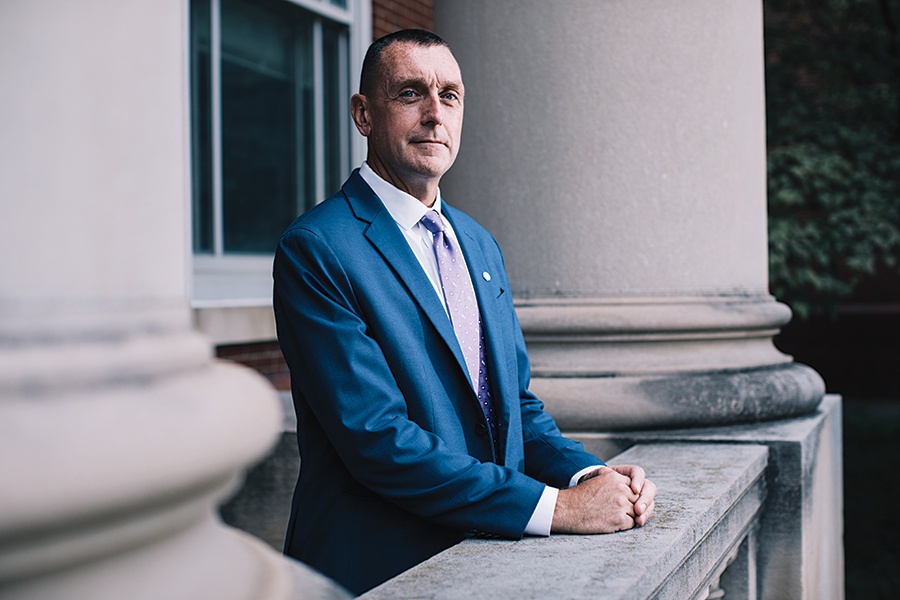
BLS enters the fall with a new head of school, Jason Gallagher. / Photo by Matt Kalinowski
On a recent afternoon, BLS parent Denise Wilson-Joutras stood in the low sunlight of Franklin Park, watching Black, white, Asian, and Latinx families of BLS students walking in pairs under the shade of tree canopies lining the historical park. She gripped a whistle, watching the clock. It was a peaceful scene as pairs of parents walked side by side, engaged in private discussions. They were there to learn from one another and share their experiences, concerns, and feelings about BLS.
“When was the first time you realized your race?” one parent asked another. They were addressing questions provided by Families for Equity and Diversity, a BLS parents’ group cochaired by Wilson-Joutras, whose twins attend the prestigious exam school. Wilson-Joutras looked at her watch. The timer struck five minutes. She blew the whistle.
“If you didn’t meet someone, pair up with them,” she called out.
People shook hands and smiled before moving on to others they hadn’t yet chatted with, almost like parent speed-dating, albeit under the heavy weight of racial tensions. There in Franklin Park, though, the scene was a portrait of civility and productive communication—a noticeably far cry from the social-media-fueled controversies of the past few months.
In general, interactions among students within the school have also been more peaceful than the public discourse would suggest. When the essay dust-up erupted online in May (largely among adults), former school head Skerritt says she had frank conversations with students and faculty, assured the students who wrote the essays that they did nothing wrong, and brought in the city’s poet laureate to lead a student discussion on the essay project. “While the social media dialogue got very intense and sometimes unpleasant or even worse, that was not the tone of the building or of our students,” Skerritt says. “We are creating spaces where students can share their experiences with one another and have conversations that are often more constructive and more productive than adults.”
It’s no stretch to say that the debate surrounding BLS doesn’t even begin to address the underlying problems with race and education in Boston. “We have to be providing a high quality of education for every family from birth to high school,” says Andrea Campbell, a former city councilor and BLS alum who is now running for state attorney general. She believes the solution lies in rebuilding the entire district—from the bottom up—so that all schools thrive. Former BLS head Contompasis, who is also a former BPS superintendent, agrees. “There is a need to improve the access to quality in all of the schools in the district so that we’re not getting kids who are deficient in what they need by completion of sixth grade,” he says. “It won’t be enough until the district deals with the problems that have been well documented over a long period of time.”
With a new superintendent, Mary Skipper, formerly of Somerville schools, now at the helm of the district, it remains to be seen exactly how and when inequities within the school system will be addressed. In the meantime, the debate over BLS continues among the broader Boston community—and in court. A group of white and Asian parents whose children were denied admission to BLS for the 2021 to 2022 school year under the ZIP code policy have filed a lawsuit against the school in the federal appeals court after a lower court upheld the new admissions policy as constitutional. The parents who filed the lawsuit are hoping for a reversal based on new evidence—the texts sent between city councilors—that they claim proves racism fueled the policy change.
Some supporters of the lawsuit believe it will eventually make its way to the U.S. Supreme Court. “Sooner or later,” says Darragh Murphy, a Dorchester resident and education activist who runs the Facebook group BPS Watch, “this case or another like it will go to the Supreme Court, and they will have to decide if these types of race-balancing admissions policies violate the 14th Amendment.”
In the meantime, Jason Gallagher, a lifelong Charlestown resident and former elementary school principal, will be BLS’s new head of school starting this fall after Skerritt stepped down for personal reasons. As for the new seventh graders admitted this year, 22 percent were Black and 21 percent Latinx, up from 6 and 12 percent in 2020, respectively. Slightly more Asian seventh graders were admitted this fall—29 percent, up from 27 in 2020—but far fewer white seventh graders, down to just 23 percent from 50 percent. In a city where the under-18 population is 23 percent white, 33 percent Black, 30 percent Latinx, and 7 percent Asian, it remains to be seen whether this new class breakdown helps quell or adds fuel to the controversy. Still, one thing is clear: When students return to school this month, Boston Latin will look like a very different place.
Note: This story originally contained an error. Tim Sullivan is not a member of the Ward 20 Republican Committee and left the party in 2021.
